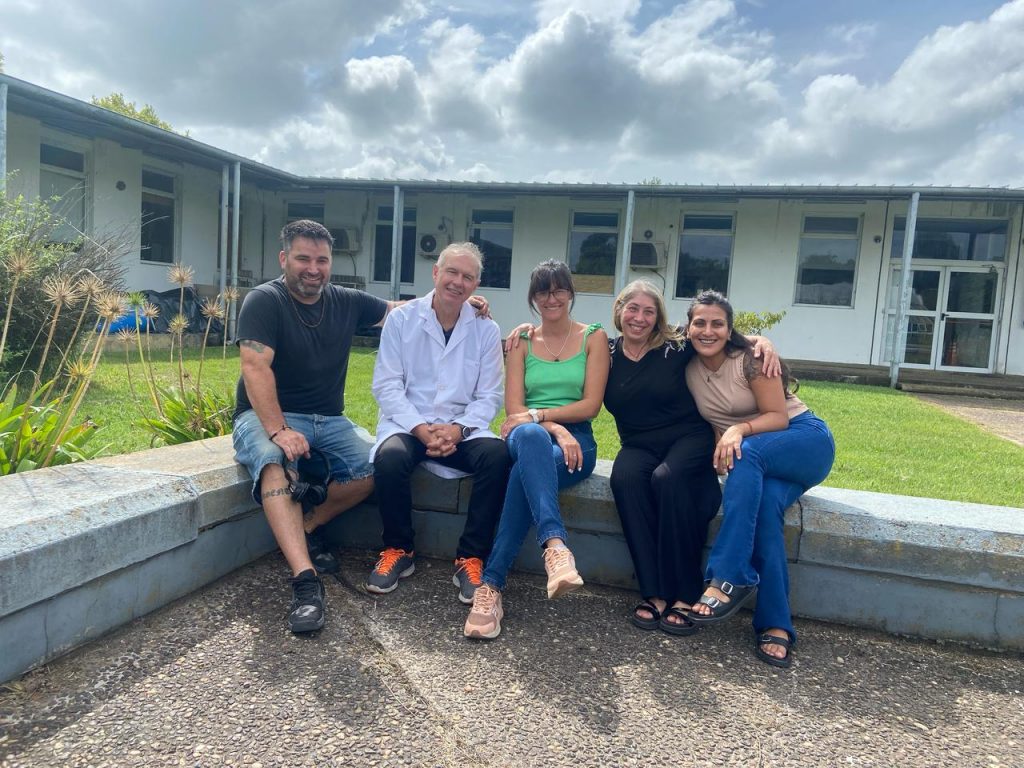Mycology and Edible Fungi Laboratory
Head

- Edgardo Albertó, PhD - Principal Researcher CONICET. Associate Professor UNSAM ealberto@intech.gov.ar
Members
- Graciela Noemí Pose, PhD - Independent Researcher CONICET. Associate Professor UNQUI posegraciela@intech.gov.ar

- Mariana G. Corigliano, PhD - Assistant Researcher CONICET. Head of practical work UNSAM marianacorigliano@intech.gov.ar

- Santiago Jaramillo Mejía, PhD Assistant UNSAM - sjaramillo@intech.gov.ar

- Noelia Soledad Ramírez, Eng. Doctoral Fellow CONICET - sramirez@intech.gov.ar

- Dámaris Evelyn Lining, Lic . Doctoral Fellow CONICET - dlining@intech.gov.ar
Support Staff

- Martín Sierra Marina - UNSAM
Research Lines
We work on the genera Agaricus, Agrocybe, Pleurotus among others of interest due to their edibility. For the identification of the species we are based on:
a) morphological characters, both macro and microscopic
b) sexual compatibility tests by crossing strains of wild fungi and control strains to define compatibility between them.
c) studies applying molecular biology techniques for the characterization of species in collaboration with other groups.
Wild edible mushroom strains are of great interest as they have adaptive advantages to the region’s climate, pests and diseases.In our country, the edible mushroom species that are cultivated come from the use of European strains that are generally from more common climates. Our objective is to obtain and study edible wild mushroom species, obtain and select strains that are productive and useful for the industry.We have especially concentrated our efforts on species of the genera Agaricus, Pleurotus, Polyporus, Gymnopilus and Agrocybe. We test different substrates to study the adaptation of strains to them. This work is done in collaboration with PRHIDEB-CONICET and the Instituto Fitotécnico de Santa Catalina (FCAyF, UNLP).
Some fungi produce Mevinolin, which is an inhibitor of the enzyme 3-hydroxymethyl 3-methylglutaryl-coenzymeA (HMG-CoA), one of the main ones involved in the synthesis of cholesterol.We study the biological significance that this enzyme may have in nature against nematodes and other competing fungi.
We study the effect that the presence of the C. melliolens fungus causes on pasture growth, which defines rings in the field of several meters in diameter where the grass develops 20 times more compared to the surrounding area.
In the depressed region of the Salado, the soils are subjected to great stress mainly because during much of the year they are flooded and flooded. The area around the Institute is purely livestock and is used for fattening cattle. Lotus glaber is a legume that has been adapted and naturalized in the area and provides an important food for livestock. For this reason we are studying whether mycorrhizae help the plant in stress situations. We also study stress in relation to this system and the metabolism of polyamines .This work is carried out in collaboration with Dr. O. Ruiz from INTECH.
The application of thermal treatments allows to delay the ripening of the strawberry and reduce the development of pathogens, prolonging the post-harvest life of the fruit. We investigated the action that these treatments have on Rhizopus stolonifer and Botrytis cinerea, two common pathogens that affect this species. carried out in collaboration with Drs. M. Civello and G. Martínez from the Fruits Maturation Lab of INTECH.
Publications
Ramirez NS, Lining D, Albertó E, Pose G. Effect on viability and yield on Pleurotus pulmonarius and Ganoderma lucidum after 3 years of cryopreservation without cryoprotectants. Cryobiology 118, 105204. 2025. https://doi.org/10.1016/j.cryobiol.2025.105204
Ganuza M, Jaramillo MS, Albertó E. Reutilization of brewer’s spent grain as spent mushroom substrate for the generation of biogas in a semi-continuous digester. Waste and Biomass Valorization 15, 2961-2971. 2024. https://doi.org/10.1007/
Jaramillo Mejía S, Colavolpe MB, Ganuza M, Albertó E. Use of Ozone as a substrate treatment for the control of Trichoderma in the production of Pleurotus ostreatus. Current Microbiology, 81, 181. 2024. https://doi.org/10.1007/s00284-024-03691-z
Marangi MJ, Temperini CV, Greco M, Pardo AG, Pose GN. Distribution of Xanthomonas arboricola pv. juglandis and Alternaria species-groups populations associated with brown apical necrosis at different phenological stages of walnut trees. European Journal of Plant Pathology 168, 83-95. 2024. https://doi.org/10.1007/s10658-023-02730-y
Ganuza M, Jaramillo Mejía S, Albertó E. Reutilization of brewer’s spent grain as spent mushroom substrate for the generation of biogas in a semi-continuous digester. Waste and Biomass Valorization. En prensa. https://doi.org/10.1007/s12649-023-02349-4
Tudela MAA, Gimenez GN, Di Masi SN, Pose GM, Basanta M. Susceptibility of South American pear cultivars to brown spot of pear caused by Stemphylium vesicarium. Journal of Plant Diseases and Protection 130, 1347–1356. https://doi.org/10.1007/s41348-023-00783-z
Tudela MAA, Lutz MC, Giménez GN, del Brío D, Di Masi SN, Pose GN, Molina JPE. Efficacy of fungicides against brown spot of pear in Argentina. Crop Protection 174, 106425. 2023. https://doi.org/10.1016/j.cropro.2023.106425
Alberti M, Jaramillo Mejía S, Pérez-Chávez M, Lio V, Albertó E. Effects of incubation time and “Browning” on yield and proximate composition of the edible mushroom Lentinula edodes. Brazilian Archives of Biology and Technology 65, 1-10. 2022. https://doi.org/10.1590/
Coniglio RO, Díaz GV, Barua RC, Albertó E, Zapata PD. Enzyme-assisted extraction of phenolic compounds and proteins from sugarcane bagasse using a low-cost cocktail from Auricularia fuscosuccinea. International Journal of Food Science and Technology 57, 2, 1114-1121. 2022. https://doi.org/10.1111/ijfs.
Coniglio R, Díaz, G, López D, Restelli M, Grassi E, Albertó E, Zapata P. Solid-state bioprocessing of sugarcane bagasse with Auricularia fuscosuccinea for phenolic compounds extraction. Preparative Biochemistry & Biotechnology 52, 701-710. 2022. https://doi.org/10.1080/10826068.2021.1986722
Perez-Chávez AM, Alberti MM, Albertó E. Evaluation of ligninolytic activity in spent mushroom substrate from four cultivated mushrooms. Journal of Bioresources and Bioproducts 7, 288-294. 2022. https://doi.org/10.1016/j.jobab.2022.09.001
Temperini CV, Aluminé Tudela MA, Gimenez GN, Di Masi SN, Pardo AG, Pose GN. Brown spot of pear, an emerging disease in Argentina: identification and pathogenicity characterization of Argentinean Stemphylium vesicarium isolates. European Journal of Plant Pathology 163, 529-544. 2022. https://doi.org/10.1007/
Alberti MM, Pérez-Chávez AM, Niveiro N, Albertó E. Towards an optimal methodology for basidiomes production of naturally occurring species of the genus Oudemansiella (Basidiomycetes). Current Microbiology 78, 1256-1266. 2021. https://doi.org/10.1007/
Greco M, Pose G, Pardo A. Growth characterization and predictive behavior of Eurotium species in a feedstuff matrix. Revista Argentina de Microbiologia 53, 248-256. 2021. https://doi.org/10.1016/j.ram.2020.09.006
Niveiro N, Alberti M, Ramírez NA, Albertó EO. Clitocybula azurea in Argentina: redescription and phylogenetic position. Mycotaxon Volume 136, 235-247. 2021. https://doi.org/10.5248/136.
Niveiro N, Ramirez NA, Baroni TJ, Jiménez S, Popoff O, Albertó E.Claudopus niger (Entolomataceae-Basidiomycota), a new species from the Argentinean Atlantic Forest. New Zealand Journal of Botany 60, 159-168. 2021. https://doi.org/10.1080/2021.1955714
Temperini CV, Franchi ML, Greco MV, Marangi MJ, Segura JA, Pose GN. Characterization of the superficial mycobiota of artisanal sausages for the development of autochthonous starter cultures. LWT-Food Science and Techology 152, 152, 112268. 2021. https://doi.org/10.1016/j.lwt.
Alberti M, Niveiro N, Cunha Zied D, Albertó E. Identification of Oudemansiella canarii and O. Cubensis (Basidiomycota, physalacriaceae) in Argentina using morphological, culture and molecular analysis. Harvard Papers in Botany 25, 131-143. 2020. https://doi.org/10.3100/hpib.v25iss2.2020.n1
Marangi MJ, Temperini CV, Fernández D, Pardo AG, Pose GN. First report of Bacterial Spot with gum production in almond fruits of Argentina. Revista de Investigaciones Agropecuarias 46, 177-180. 2020.
Niveiro N, Uhart M, Albertó E. Revision of the genera Agrocybe and Cyclocybe (Strophariaceae, Agaricales, Basidiomycota) in Argentina. Rodriguésia 71, e02272018. 2020. https://doi.org/10.1590/2175-7860202071038
Pavicich MA, Cárdenas P, Pose GN, Fernández Pinto V, Patriarca A. From field to process: How storage selects toxigenic Alternaria spp. causing mouldy core in Red Delicious apples. Int J Food Microbiol. 322, 108575. 2020. https://doi.org/10.1016/j.ijfoodmicro.2020.108575
Pérez-Chávez AM, Mayer L, Albertó E. Mushroom cultivation and biogas production: A sustainable reuse of organic resources. Energy Sustain Dev. 50: 50-60. 2019. https://doi.org/10.1016/j.esd.2019.03.002


